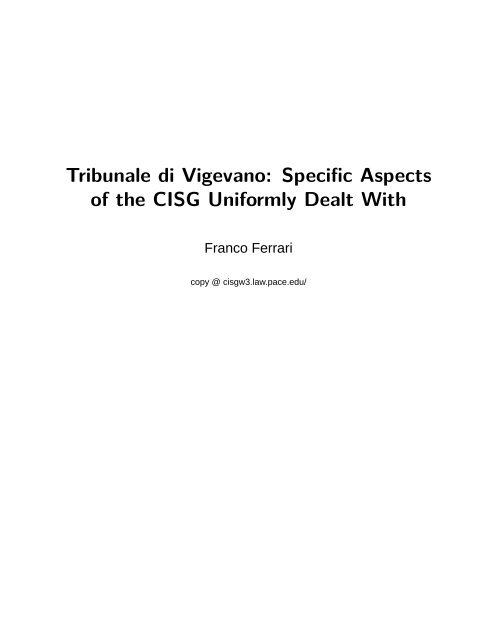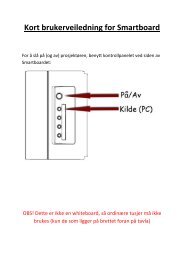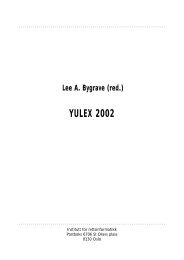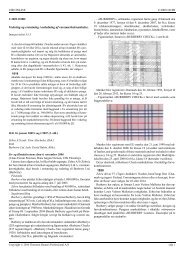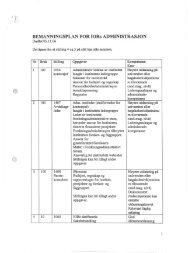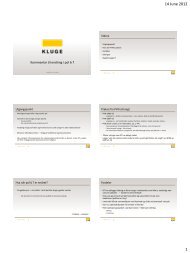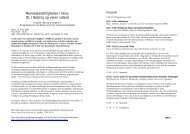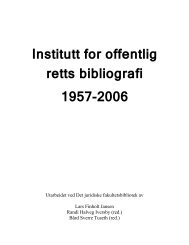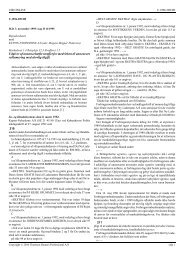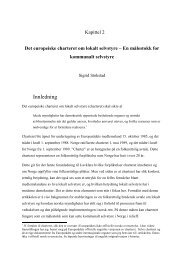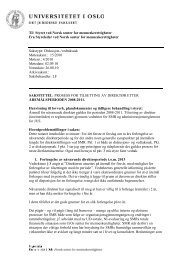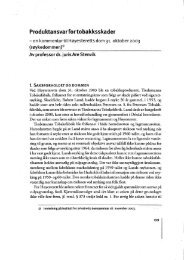PDF, U.S. letter size, portrait/vertical document
PDF, U.S. letter size, portrait/vertical document
PDF, U.S. letter size, portrait/vertical document
Create successful ePaper yourself
Turn your PDF publications into a flip-book with our unique Google optimized e-Paper software.
Tribunale di Vigevano: Specific Aspects<br />
of the CISG Uniformly Dealt With<br />
Franco Ferrari<br />
copy @ cisgw3.law.pace.edu/
CISG Database, Pace Institute of International Commercial Law. Reproduced with permission<br />
of 20 “Journal of Law and Commerce” (Spring 2001) 225-239;<br />
SiSU cisgw3.law.pace.edu/ ii
Contents<br />
Contents<br />
Tribunale di Vigevano: Specific Aspects of the CISG Uniformly Dealt With,<br />
Franco Ferrari 1<br />
I. Autonomous Interpretation of the CISG . . . . . . . . . . . . . . . . . . . . . . 1<br />
II. Interpreting the CISG in Light of Foreign Case Law . . . . . . . . . . . . . . . 3<br />
III. Uniform Interpretation and Application of the CISG by Courts Prior to the Decision<br />
of the Tribunale di Vigevano . . . . . . . . . . . . . . . . . . . . . . . 5<br />
IV. The Importance of the Decision of the Tribunale di Vigevano . . . . . . . . . . 6<br />
V. Exclusion of the CISG . . . . . . . . . . . . . . . . . . . . . . . . . . . . . . . . 7<br />
VI. Timely Notice of Non-Conformity . . . . . . . . . . . . . . . . . . . . . . . . . 9<br />
VII. Specificity of the Notice of Non-Conformity . . . . . . . . . . . . . . . . . . . 10<br />
VIII. Burden of Proof Under the CISG . . . . . . . . . . . . . . . . . . . . . . . . 11<br />
IX. Conclusion . . . . . . . . . . . . . . . . . . . . . . . . . . . . . . . . . . . . . 14<br />
Metadata 15<br />
SiSU Metadata, <strong>document</strong> information . . . . . . . . . . . . . . . . . . . . . . . . 15<br />
SiSU cisgw3.law.pace.edu/ iii
Tribunale di Vigevano: Specific Aspects of the CISG Uniformly Dealt With<br />
Tribunale di Vigevano: Specific Aspects of the CISG Uniformly Dealt 1<br />
With,<br />
Franco Ferrari *<br />
I. Autonomous Interpretation of the CISG 2<br />
It is common knowledge 1 that in order to create international legal uniformity, it is insuffi- 3<br />
cient to merely create and enact uniform laws or uniform law conventions, 2 because “even<br />
when outward uniformity is achieved [...], uniform application of the agreed rules is by no<br />
means guaranteed, as in practice different countries almost inevitably come to put different<br />
interpretations upon the same enacted words.” 3 The drafters of the most recent international<br />
uniform commercial law conventions were aware of this, as evidenced by the fact that<br />
they inserted into these conventions provisions designed to reduce the danger of diverging<br />
interpretations. 4 This is also true as far as the United Nations Convention on Contracts for<br />
the International Sale of Goods, 5 (CISG) 6 is concerned. According to Article [page 225]<br />
7(1), 7 in interpreting the CISG, “regard is to be had to its international character and to the<br />
need to promote uniformity in its application.” According to many legal writers who have<br />
dealt with interpretation of the CISG, 8 this means that in interpreting it one should always<br />
1 See, e.g., Dieter Martiny, Autonome und einheitliche Auslegung im Europäischen Internationalen<br />
Zivilprozeßrecht, RABELS ZEITSCHRIFT FÜR AUSLÄNDISCHES UND INTERNATIONALES<br />
PRIVATRECHT 427, 427 (1981).<br />
2 Lisa M. Ryan, The Convention on Contracts for the International Sale of Goods: Divergent<br />
Interpretations, 4 TUL. J . INT'L and COMP. L. 99, 101 (1995), stating that “textual uniformity [...] is<br />
insufficient.”<br />
3 R.J.C. Munday, Comment, The Uniform Interpretation of International Conventions, 27 INT'L and COMP.<br />
L.Q. 450 (1978).<br />
4 It has often been stated that it is only possible to reduce the danger of diverging interpretations; it is not<br />
possible to eliminate them altogether; see, e.g., JOSEPH M. LOOKOFSKY, CONSEQUENTIAL DAMAGES<br />
IN COMPARATIVE CONTEXT 294 (1989).<br />
5 See the United Nations Convention on Contracts for the International Sale of Goods, opened for<br />
signature April 11, 1980, 19 I.L.M. 668 (entered into force Jan. 1, 1998) [hereinafter CISG].<br />
6 Many abbreviations have been used for the United Nations Convention on Contracts for the International<br />
Sale of Goods; for a court decision which lists several, see OLG Frankfurt, April 20, 1994, RECHT DER<br />
INTERNATIONALEN WIRTSCHAFT 593, 593 (1994). For a discussion in legal writing of the various<br />
abbreviations, see, e.g., Axel Flessner and Thomas Kadner, CISG? Zur Suche nach einer Abkürzung für<br />
das Wiener Übereinkommen über Verträge über den internationalen Warenkauf, ZEITSCHRIFT FÜR<br />
EUROPÄISCHES PRIVATRECHT 347 ff. (1995).<br />
7 Art. 7(1) CISG: “In the interpretation of this Convention, regard is to be had to its international character<br />
and to the need to promote uniformity in its application and the observance of good faith in international<br />
trade.”<br />
8 Several papers have been written on the interpretation of the CISG; see, e.g., Jorge Adame Goddard,<br />
* Legal Officer, United Nations Office of Legal Affairs, International Trade Law Branch; Full Professor of<br />
Comparative Private Law, Bologna University Faculty of Law (on leave); the views expressed in this paper<br />
are those of the author and do not necessarily reflect those of the United Nations.<br />
SiSU cisgw3.law.pace.edu/ 1
Tribunale di Vigevano: Specific Aspects of the CISG Uniformly Dealt With<br />
take into consideration that it is a result of international unification efforts, 9 i.e. that it was<br />
not elaborated, unlike any domestic statute, with any particular legal system or language in<br />
mind. 10 Thus, it has been suggested that it is necessary to read the CISG not through the<br />
lenses of domestic law, 11 but rather in an autonomous manner. 12 This is why in interpreting<br />
the CISG one should not resort to the meaning generally attached to certain expressions<br />
within the ambit of a particular legal system. 13 This is also true in those cases where the<br />
expressions adopted in the [page 226] various original versions of the CISG correspond<br />
to expressions to which a particular meaning is attached in specific legal systems, 14 provided<br />
that the legislative history does not show that an expression was chosen because a<br />
particular meaning attached to it. 15<br />
Reglas de interpretacion de la Convencion sobre Compraventa Internacional de Mercaderias, REVISTA<br />
DE INVESTIGACIONES JURIDICAS 9 ff. (1990); Michael J . Bonell, L'interpretazione del diritto uniforme<br />
alIa luce dell'art. 7 della convenzione di Vienna sulla vendita internazionale, RIVISTA DI DIRITTO CIVILE<br />
221 ff. (1986/II); V. Susanne Cook, Note, The Need for Uniform Interpretation of the 1980 United Nations<br />
Convention on Contracts for the International Sale of Goods, 50 U. PITT. L.REV. 197 ff. (1988); Franco<br />
Ferrari, Interpretation uniforme de la Convention de 1980 sur la vente internationale, REVUE<br />
INTERNATIONALE DE DROIT COMPARE 813 ff. (1996); Maria d.P. Perales Viscasillas, Una<br />
aproximacion al articulo 7 de la Convencion de Viena de 1980 sobre compraventa intemacional de<br />
mercaderias, QUADERNOS DE DERECHO Y COMERCIO 55 ff. (1995/XVI).<br />
9 WERNER MELIS, Art. 7, in KOMMENTAR ZUM UN-KAUFRECHT 87 (Heinrich Honsell ed., Zürich<br />
1997); ROLAND LOEWE, INTERNATIONALES KAUFRECHT 32 (Vienna, 1989).<br />
10 MARTIN KAROLLUS, UN-KAUFRECHT. EINE SYSTEMATISCHE DARSTELLUNG FÜR STUDIUM<br />
UND PRAXIS 11 (Vienna, 1991).<br />
11 See, e.g., JohnO. Honnold, The Sales Convention in Action - Uniform International Words: Uniform<br />
Applications?, 8 J. L .and COM. 207, 208 (1988), where the author states that “one threat to international<br />
uniformity in interpretation is a natural tendency to read the international text through the lenses of<br />
domestic law.”<br />
See also Andrew Babiak, Defining “Fundamental Breach” under the United Nations Convention on<br />
Contracts for the International Sale of Goods, 6 TEMP. INT'L and COMP. L. J . 113, 117 (1992).<br />
12 BERNARD AUDIT, LA VENTE INTERNATIONALE DE MARCHANDISES 47 (Paris 1990); Michael J .<br />
Bonell, Commento all'art. 7 della Convenzione di Vienna, NUOVE LEGGI CIVILI COMMENTATE 21, 21<br />
(1989); Frank Diedrich, Maintaining Uniformity in International Uniform Law via Autonomous Interpretation:<br />
Software Contracts under the CISG, 8 PACE INT'L L.REV. 303 ff. (1996); CHRISTOPH HÄUSLER, DAS<br />
UNIDROIT ÜBEREINKOMMEN ÜBER INTERNATIONALES FACTORING (OTTAWA 1988) UNTER<br />
BESONDERER BERÜCKSICHTIGUNG SEINER ANWENDBARKEIT 135 (Frankfurt, 1998) (stating the<br />
same, albeit with reference to the 1988 UNIDROIT Convention on International Factoring).<br />
13 JOHNO. HONNOLD, UNIFORM LAW FOR INTERNATIONAL SALES UNDER THE UNITED NATIONS<br />
CONVENTION 136 (2d ed., Deventer 1991), stating that “the reading of a legal text in the light of the<br />
concepts of our domestic legal system [is] an approach that would violate the requirement that the<br />
Convention be interpreted with regard to its international character.” See also ULRICH MAGNUS, WlENER<br />
UN-KAUFRECHT (CISG) 153 (Berlin 1999); PETER SCHLECHTRIEM, INTERNATIONALES<br />
UN-KAUFRECHT 29-30 (Tübingen 1997).<br />
14 FRANK DIEDRICH, AUTONOME AUSLEGUNG VON INTERNATIONALEM EINHEITSRECHT 77<br />
(Baden- Baden, 1994).<br />
15 Franco Ferrari, Der Begriff des “internationalen Privatrechts” nach Art. 1 Abs. 1 lit. b) des UN-Kaufrechts,<br />
ZEITSCHRIFT FÜR EUROPÄISCHES PRIVATRECHT 162, 166 (1998); MAGNUS, supra note 13, at 153.<br />
SiSU cisgw3.law.pace.edu/ 2
Tribunale di Vigevano: Specific Aspects of the CISG Uniformly Dealt With<br />
What has been said thus far is true for the criteria to be used in the interpretation process 4<br />
as well. The CISG is not to be interpreted on the basis of “domestic” interpretive criteria,<br />
since this would be detrimental to the goal pursued, i.e. the unification of (sales) law, since<br />
in different legal systems different interpretive criteria are used. 16<br />
Various authors have, however, pointed out that in order to create uniform law, it is insuf- 5<br />
ficient to “autonomously” interpret uniform law instruments. 17 This becomes even more<br />
evident if one considers that there are instances where more than one “autonomous” interpretation<br />
of the same concept are plausible. In these instances uniformity will, despite<br />
an “autonomous” interpretation, not be guaranteed; according to some legal scholars, uniformity<br />
would in these cases merely amount to a “random occurrence.” 18<br />
II. Interpreting the CISG in Light of Foreign Case Law 6<br />
The drafters of the CISG were aware that although an “autonomous” interpretation would 7<br />
certainly promote uniformity, it would not necessarily guarantee it. This is why they provided<br />
not only for the obligation to “have regard to the Convention's international character,”<br />
but also for the obligation to have regard “to the need to promote uniformity in its application.”<br />
19 This is no surprise, given the close link between these two kinds of obligations: 20<br />
[page 227] They both tend to promote uniformity and are both based upon the knowledge<br />
that the elaboration of a uniform law instrument does not per se create uniformity. 21<br />
From the obligation to have regard to the need to promote uniformity in the CISG's ap- 8<br />
plication legal scholars have deduced, on the one hand, that “whoever has to apply the<br />
Convention, must make efforts to adopt solutions which are tenable on an international<br />
level, i.e. solutions which can be taken into consideration in other Contracting States as<br />
well.” 22 The more the various concepts are interpreted “autonomously,” the more this result<br />
16 DIEDRICH, supra note 14, at 59 ff.; Hein Kötz, Rechtsvereinheitlichung-Nutzen, Kosten, Methoden, Ziele,<br />
RABELS ZEITSCHRIFT FÜR AUSLÄNDISCHES UND INTERNATIONALES PRIVATRECHT 1, 8 (1986).<br />
17 FRITZ ENDERLEIN ET AL., INTERNATIONALES KAUFRECHT. KOMMENTAR 62 (Freiburg/Berlin,<br />
1991).<br />
18 Michael F. Sturley, International Uniform Laws in National Courts; The Influence of Domestic Law in<br />
Conflicts Interpretation, 27 VA. J.INT'L L. 729,738 (1987).<br />
19 MAGNUS, supra note 13, at 155.<br />
20 For similar statements, albeit referred to in the 1988 Unidroit Convention on International Factoring, see<br />
Ferrari, supra note 15, at 111 et seq.<br />
21 HÄUSLER, supra note 12, at 136 f. (albeit in respect to the 1988 UNIDROIT Convention on International<br />
Factoring).<br />
22 MAGNUS, supra note 13, at 155 (with respect to the CISG); see also HAUSLER, supra note 12, at 137<br />
(in respect of the 1988 UNIDROIT Convention on International Factoring); (in relazione alla Convenzione di<br />
Roma sulla legge applicabile alle obbligazioni contrattuali) Abbo Junker, Die einheitliche europäische<br />
Auslegung nach dem EG-Schuldvertragsübereinkommen, RABELS ZEITSCHRIFT FÜR<br />
AUSLÄNDISCHES UND INTERNATIONALES PRIVATRECHT 680 (1991) (in respect of the 1980 Rome<br />
Convention on the Law Applicable to Contractual Obligations).<br />
SiSU cisgw3.law.pace.edu/ 3
Tribunale di Vigevano: Specific Aspects of the CISG Uniformly Dealt With<br />
is able to be achieved. 23 On the other hand, both American 24 and foreign 25 legal writers<br />
have interpreted the aforementioned obligation to mean that in applying the CISG courts<br />
26<br />
have to take into account relevant decisions of other States. [page 228]<br />
Resorting to foreign case law undoubtedly promotes uniform application of the CISG. How- 9<br />
ever, requiring interpreters to consider foreign decisions can create practical difficulties, for<br />
two main reasons. 27 First, foreign case law is not readily available, i.e. it cannot easily be<br />
retrieved: Second, foreign case law is often written in a language unknown to the interpreter.<br />
28<br />
In order to overcome these obstacles, various steps have been undertaken. 29 UNCITRAL, 10<br />
for instance, publishes -- on the basis of a decision taken on the occasion of its twenty-first<br />
session 30 -- “CLOUT” (“Case Law on UNCITRAL Texts”), 31 a collection of abstracts of court<br />
23 Franco Ferrari, Art. 7, EINHEITLICHES UN-KAUFRECHT 126 (Peter Schlechtriem ed., Munich 2000).<br />
24 See Cook, supra note 8, at 226; V. Susanne Cook, The U.N. Convention on Contracts for the<br />
International Sale of Goods: A Mandate to Abandon Legal Ethnocentricity, 16 J.L. and COM. 257, 261<br />
(1997); Joanne M. Darkey, A U.S. Court's Interpretation of Damage Provisions under the U.N. Convention<br />
on Contracts for the International Sale of Goods: A Preliminary Step towards an International<br />
Jurisprudence of CISG or a Missed Opportunity?, 15 J.L. andCOM. 139, 142 (1995); Helen E. Hartnell,<br />
Rousing the Sleeping Dog: The Validity Exception to the Convention on Contracts for the International Sale<br />
of Goods, 18 YALE J. INT'L L. 1, 7 (1993); JOHN O. HONNOLD, UNIFORM LAW FOR INTERNATIONAL<br />
SALES 95 ff. (The Hague, 1999); ALBERT H. KRITZER, GUIDE TO PRACTICAL APPLICATIONS OF THE<br />
UNITED NATIONS CONVENTION ON CONTRACTS FOR THE INTERNATIONAL SALE OF GOODS 109<br />
(Deventer, 1989); Elizabeth H. Patterson, United Nations Convention on Contracts for the International<br />
Sale of Goods: Unification and the Tension Between Compromise and Domination, 22 STAN. J. INT'L L.<br />
263, 283 (1986); Peter Winship, Changing Contract Practices in the Light of the United Nations Sales<br />
Convention: A Guide for Practitioners, 29 INT'L LAW. 525, 528 (1995).<br />
25 MICHAEL J. BONELL, Art. 7, COMMENTARY ON THE INTERNATIONAL SALES LAW (a cura di<br />
Cesare Massimo Bianca e Michael J. Bonell, Milano 1987); ENDERLEIN ET AL., supra note 17, at 62;<br />
FRANCO FERRARI, VENDITA INTERNAZIONALE DI BENI MOBILI. AMBITO DI APPLICAZIONE.<br />
DISPOSIZIONI GENERALI 138 (Bologna, 1994); ROLF HERBER and BEATE CZERWENKA,<br />
INTERNATIONALES KAUFRECHT 48 (Munich, 1991); MAGNUS, Währungsfragen, cit., 123; DIETRICH<br />
MASKOW, THE CONVENTION ON THE INTERNATIONAL SALE OF GOODS FROM THE PERSPECTIVE<br />
OF THE SOCIALIST COUNTRIES, in LA VENDITA INTERNAZIONALE 54 (Milan 1981); BURGHARD<br />
PILTZ, INTERNATIONALES KAUFRECHT 66 (Munich 1993); MAGNUS, supra note 13, at 155.<br />
26 Ferrari, supra note 8, at 831-832.<br />
27 See generally Franco Ferrari, CISG Case Law: A New Challenge for Interpreters?, 17 J.L. and COM.<br />
245 (1998).<br />
28 This appears to be a problem above all for U.S. judges; indeed, various U.S. court decisions expressly<br />
refer to the “lack of case law” concerning the CISG at a time when there were already many foreign CISG<br />
cases, Helen Kaminski PTY LTD. v. Mktg. Australian Prod., Inc., Nos. M-47 (DLC), 96846514, 97-8072A,<br />
at *3 (S.D.N.Y. July 23, 1997).<br />
29 Rolf Herber, CLOUT, Unilex and andere Veröffentlichungen zum internationalen Kaufrecht, RECHT DER<br />
INTERNATIONALEN WIRTSCHAFT 502 ( 1995).<br />
30 Report of the United Nations Commission on International Trade Law on the Work of its Twenty-First<br />
Session, 11-22 April 1988, YB XIX 98 (1988).<br />
31 This collection of abstracts can also be found on the internet, available at ‹http://www.uncitral.org›.<br />
SiSU cisgw3.law.pace.edu/ 4
Tribunale di Vigevano: Specific Aspects of the CISG Uniformly Dealt With<br />
decisions from all over the world dealing with UNCITRAL texts, among others the CISG. 32<br />
Additionally, the Centre for Comparative and Foreign Law Studies in Rome has developed<br />
UNILEX, a collection of case law and an international bibliography on the CISG, 33 which<br />
aims at promoting the knowledge of foreign case law. 34 Finally, various universities have<br />
created web sites on the Internet where, at no cost, foreign court decisions, especially<br />
French, 35 German 36 and American ones 37 can be retrieved.<br />
One must wonder, however, whether the knowledge of foreign case law is sufficient to solve 11<br />
all the substantive issues. In my opinion, it cannot. 38 The knowledge of foreign case law is<br />
not per se sufficient to guarantee uniformity, [page 229] as the knowledge of domestic case<br />
law does not avoid all interpretative problems within a particular legal jurisdiction. If the<br />
knowledge of foreign case law were sufficient to create uniformity in the CISG's application,<br />
this would mean, if taken to an extreme, that the first position taken on a specific issue by<br />
any court would be the one shaping all the successive case law. This can hardly be true,<br />
especially since foreign case law has, according to the majority view, merely persuasive<br />
value. 39<br />
III. Uniform Interpretation and Application of the CISG by Courts Prior to the 12<br />
Decision of the Tribunale di Vigevano<br />
It goes without saying that courts, too, are obliged to have regard to the CISG's inter- 13<br />
national character in interpreting it. Some courts have indeed referred to this obligation.<br />
For instance, a Swiss court decision states that in interpreting the CISG “one has to have<br />
particular regard to its international character (Article 7(1)). The starting point of any interpretation<br />
must be the Convention itself not domestic law.” 40 One Italian tribunal also has<br />
mentioned the need to take into account the CISG's international character in interpreting<br />
32 See also Ferrari, supra note 8, at 813.<br />
33 Fabio Liguori, UNILEX: A Means to Promote Uniformity in the Application of CISG, ZEITSCHRIFT FÜR<br />
EUROPÄISCHES PRIVATRECHT 600 (1996) (commenting on the database).<br />
34 Herber, supra note 29, at 502.<br />
35 CISG France at ‹http://www.jura.uni.sb.de/FB/LS/Witz/cisg.htm›<br />
36 CISG Online at ‹http://www.jura.uni-freiburg.de/ipr1/cisg›<br />
37 Institute of International Commercial Law of Pace University School of Law, at<br />
‹http://cisgw3.1aw.pace.edu› Albert H. Kritzer, The Convention on Contracts for the International Sale of<br />
Goods: Scope, Interpretation and Resources, 1995 REVIEW OF THE CONVENTION ON CONTRACTS<br />
FOR THE INTERNATIONAL SALE OF GOODS 147 (1995).<br />
38 Franco Ferrari, Brevi considerazioni critiche in materia di interpretazione autonoma ed applicazione<br />
uniforme della Convenzione di Vienna, RIV. DIR. CIV. vol. 2 1998, at 93.<br />
39 See generally Franco Ferrari, La jurisprudence sur la CVIM: un nouveau defi pour les interpretes?,<br />
REVUE DE DROIT DES AFFAIRES INTERNATIONALES 495, 503 (1998); Emst A. Kramer, Uniforme<br />
Interpretation von Einheitsprivatrecht-mit besonderer Berücksichtigung von Art. 7 UNKR,<br />
ÖSTERREICHISCHE JURISTISCHE BLÄTTER 143, 146 (1996); Melis, supra note 9, at 88; Magnus,<br />
Währungsfragen, supra note 6, at 123.<br />
40 Gerichtspräsident Laufen, May 7, 1993, UNILEX.<br />
SiSU cisgw3.law.pace.edu/ 5
Tribunale di Vigevano: Specific Aspects of the CISG Uniformly Dealt With<br />
it. 41 A similar view was taken by a German court decision, which empha<strong>size</strong>d the need to<br />
have regard to the Convention's international character. 42 Reference to the need to avoid<br />
interpreting the CISG in the light of domestic law can be found in some U.S. cases as well.<br />
In one case, the court stated that “although the CISG is similar to the UCC with respect to<br />
certain provisions, [...] it would be inappropriate to apply the UCC case law in construing<br />
contracts under the CISG.” 43 A very similar statement was recently made by [page 230] the<br />
German Supreme Court in respect to the possibility to apply German case law regarding<br />
the Commercial Code to the CISG. 44<br />
It must be pointed out, however, that the courts are not only bound to interpret the CISG 14<br />
“autonomously;” they are also obliged to have regard to the need to promote uniformity in<br />
the Convention's application by taking foreign case law into account. Nevertheless, only<br />
a few court decisions have, to date, referred to foreign case law. 45 In one Italian case 46<br />
two foreign court decisions were referred to analytically, one German 47 and one Swiss, 48<br />
in order to decide whether a notice of non-conformity given to the seller twenty-three days<br />
after delivery of sporting clothes that turned out to be larger than was agreed upon was<br />
timely. This issue was also dealt with by a more recent Italian court decision, 49 in which<br />
the court analyzed a Swiss court decision. 50 In another case, a French court 51 quoted a<br />
German court decision 52 without, however, examining it at all.<br />
IV. The Importance of the Decision of the Tribunale di Vigevano 15<br />
If one takes into account what has just been said, the importance of the decision of the 16<br />
Tribunale di Vigevano, Italy is self-evident. When dealing with some of the typical issues<br />
raised by the CISG, such as party autonomy, notice of non-conformity and burden of proof,<br />
41 Tribunale di Pavia, December 29, 1999, CORRIERE GIURIDICO 932 (2000); Franco Ferrari, Rapporto<br />
tra diritto materia le uniforme di origine convenzionale e diritto internazionale privato, CORRIERE<br />
GIURIDICO 933 (2000) (commenting on this decision).<br />
42 OLGFrankfurt, Apri1 20, 1994, RECHT DER INTERNATIONALEN WIRTSCHAFT 595 (1994).<br />
43 Claudia v. Olivieri Footwear Ltd., No. 96 Civ. 8052 (HB) (THK) 1998 WL 164824, at *4 (Apr. 7, 1998); for<br />
similar affirmations, see also Delchi Carrier S.p.A. v. Rotorex Corp., 71 F.3d 1024, 1028 (2d Cir. 1995)<br />
(stating that “UCC case law is not per se applicable”); Orbisphere Corp. v. United States, 726 F. Supp.<br />
1344, 1355 (Ct. lnt'l Trade 1989) (stating the same).<br />
44 BGH, April 3, 1996, JURISTEN ZEITUNG 35 (1997).<br />
45 See generally Ferrari, supra note 39, at 495.<br />
46 Tribunale di Cuneo, January 31, 1996, UNILEX.<br />
47 LG Stuttgart, August 31, 1989, PRAXIS DES INTERNATIONALEN PRIVAT- UND<br />
VERFAHRENSRECHTS 317 (1990).<br />
48 Pretura Locarno-Campagna, April 27, 1992, UNILEX.<br />
49 Tribunale di Pavia, December 29, 1999, supra note 41.<br />
50 Pretura Locarno-Campagna, December 16, 1991, SCHWEIZERISCHE ZEITSCHRIFT FÜR<br />
EUROPÄISCHES UND INTERNATIONALES RECHT 665 (1993).<br />
51 Cour d'appe1 Grenoble, October 23, 1996, UNILEX.<br />
52 OLG Düsseldorf, July 2, 1992, RECHT DER INTERNATIONALEN WIRTSCHAFT 45 (1993).<br />
SiSU cisgw3.law.pace.edu/ 6
Tribunale di Vigevano: Specific Aspects of the CISG Uniformly Dealt With<br />
the court referred to about 40 foreign court decisions and arbitral awards. 53 The court has,<br />
in other words, more than any other court before it, taken into account the need to have<br />
regard to foreign case law in order to promote uniformity. It has done so, however, with<br />
the awareness that foreign case law is not binding. This is evident from the decision itself.<br />
Indeed, the court expressly states that foreign case law, “albeit non-binding, as suggested<br />
by a few legal writers, must nevertheless be taken into account in order to guarantee and<br />
promote a uniform application of [page 231] the Vienna Sales Convention.” 54 The court<br />
correctly rejected the minority view, 55 which attributes binding force to foreign case law<br />
and which even asks for the creation of a “supranational stare decisis.” 56 As far as the<br />
suggestion to create a “supranational stare decisis” is concerned, it does not take into<br />
account the rigid hierarchical structure of the court system which the stare decisis doctrine<br />
presupposes and which on an international level is lacking. 57<br />
The decision of the Tribunale di Vigevano is, however, noteworthy not only because of the 17<br />
large number of foreign cases quoted and the statement that foreign case law merely has<br />
persuasive value, but also because the court quoted, apart from decisions published in law<br />
reviews, decisions published in the UNILEX database as well as in two of the aforementioned<br />
online databases. 58<br />
V. Exclusion of the CISG 18<br />
One of the issues touched upon by the court relates to the parties' possibility to exclude the 19<br />
CISG, 59 which led several authors to label the CISG as a “dispositive” convention. 60 After<br />
53 In its decision, the court referred to court decisions from Austria, France, Germany, the Netherlands,<br />
Switzerland and the United States.<br />
54 Tribunale di Pavia, December 29, 1999, supra note 41, at 933 (expressly stating that “foreign case law<br />
merely has persuasive value.”).<br />
55 Cf. SCHLECHTRIEM, supra note 13, at 29-30; MAGNUS, supra note 13, at 21. Albeit with reference to<br />
the UNIDROIT Convention on International Factoring, see also FRANCO FERRARI, IL FACTORING<br />
INTERNAZIONALE 115 (Padova, 1999).<br />
56 Larry A. Dimatteo, An International Contract Law Formula: The Informality of International Business<br />
Transactions Plus the Internationalization of Contract Law Equals Unexpected Contractual Liability, 23<br />
SYRACUSE J. INT'L L. and COM. 67, 78-79 (1997); Larry A. Dimatteo, The CISG and the Presumption of<br />
Enforceability: Unintended Contractual Liability in International Business Dealings, 22 YALE INT'L L.J. 111,<br />
133 (1997).<br />
57 See also Ferrari, supra note 23, at 128.<br />
58 Supra notes 33-37<br />
59 For papers on the exclusion of the CISG, see Rüdiger Holthausen, Vertraglicher Ausschluß des<br />
UN-Übereinkommens über internationale Warenkaufvertäge, RECHT DER INTERNATIONALEN<br />
WIRTSCHAFT 513 (1989); Claude Witz, L'exclusion de la Convention des Nations unies sur les contrats<br />
de vente internationale de marchandises par la volonte des parties (Convention de Vienne du 11 avril<br />
1980), DALLOZ CHRONIQUE 107 (1990).<br />
60 Many legal writers have referred to the CISG's “dispositive nature”; see, for instance,<br />
WILHELM-ALBRECHT ACHILLES, KOMMENTAR ZUM UN-KAUFRECHTS ÜBEREINKOMMEN (CISG)<br />
SiSU cisgw3.law.pace.edu/ 7
Tribunale di Vigevano: Specific Aspects of the CISG Uniformly Dealt With<br />
having stated that the CISG does apply [page 232] to the case at hand by virtue of Article<br />
1(1)(a), the court expressly stated that the parties had not taken advantage of the possibility<br />
of excluding the CISG. Unlike other courts, the Tribunale di Vigevano did not, however, limit<br />
itself to emphasizing the fact that the parties had not excluded the CISG. Rather, it grasped<br />
that occasion to deal in more detail with the issue of implicit exclusion which it, like many 61<br />
-- albeit not all 62 -- courts and legal writers 63 considered admissible.<br />
In its decision, the court mainly deals with the (rather practical) issue of whether the CISG 20<br />
must be considered as having been excluded where the parties pleaded on the sole basis<br />
of a particular domestic law (in the case at hand, Italian law) despite the fact that all of<br />
the CISG's criteria of applicability were met. The court correctly stated that the mere fact<br />
that the parties argue on the sole basis of a domestic law must not necessarily be taken<br />
25 (Neuwied, 2000); Sergio Carbone, L'ambito di applicazione ed i criteri interpretativi della Convenzione di<br />
Vienna sulla vendita internazionale, in LA VENDITA INTERNAZIONALE 61, 78 (Milan 1981); FRANCO<br />
FERRARI, LA VENDITA INTERNAZIONALE. APPLICABILITA ED APPLICAZIONI DELLA CONVENZIONE<br />
DI VIENNA DEL 1980, 158 (Padova 1997); JOCHEN LINDBACH, RECHTSWAHL IM EINHEITSRECHT<br />
AM BEISPIEL DES WIENER UN-KAUFRECHTS 67 (Aachen 1996); Paul Volken, Das Wiener<br />
Übereinkommen über den internationalen Warenkauf. Anwendungsvorausetzungen und<br />
Anwendungsbereich, in EINHEITLICHES KAUFRECHT UND NATIONALES OBLIGATIONENRECHT 92<br />
(Peter Schlechtriem ed., Baden-Baden 1987).<br />
61 See also OLGMünchen, 9 September 1997, FORUM FÜR INTERNATIONALES RECHT 159 (1997); LG<br />
München, 29 May 1995, NEUE JURISTISCHE WOCHENSCHRIFT 401 (1996).<br />
62 LG Landshut, 5 April 1995, UNILEX; Orbisphere Corp. v. United States, 726 F. Supp. 1344, 1355 n.7<br />
(Ct. Int'l Trade 1989).<br />
63 See also BERNARD AUDIT, LA VENTE INTERNATIONALE DE MARCHANDISES 38 (Paris 1990);<br />
Kevin Bell, The Sphere of Application of the Vienna Convention on Contracts for the International Sale of<br />
Goods, 8 PACE INT'L L.J. 237, 255 (1996); Jacopo Cappuccio, La deroga implicta nella convenzione di<br />
Vienna de1 1980, Diritto del commercio internazionale 867, 868-869 (1994); Calvo Caravaca, Art. 6, in LA<br />
COMPRA VENT A INTERNACIONAL DE MERCADERIAS 94 (Luis Diez-Picazo ed., Madrid 1998); Sergio<br />
Carbone e Riccardo Luzzatto, I contratti del commercio internazionale, in 11 TRATTATO DI DIRITTO<br />
PRIVATO 132 (Pietro Rescigno ed., Torino 1984); BEATE CZERWENKA,<br />
RECHTSANWENDUNGSPROBLEME IM INTERNATIONALEN KAUFRECHT. DAS KOLLISIONSRECHT<br />
BEI GRENZÜBERSCHREITENDEN KAUFVERTRÄGEN UND DER ANWENDUNGSBEREICH DER<br />
INTERNATIONALEN KAUFRECHTSÜBEREINKOMMEN 170 (Berlin 1988); Samuel K. Date-Bah, The<br />
United Nations Convention on Contracts for the International Sale of Goods. 1980: Overview and Selective<br />
Commentary, REVIEW OF GHANA LAW 50, 54 (1979); Franco Ferrari, Art. 6, KOMMENTAR ZUM<br />
EINHEITLICHEN UN-KAUFRECHT, supra note 23, at 113-114; ALEJANDRO GARRO E ALBERTO L.<br />
ZUPPI, COMPRAVENTA INTERNACIONAL DE MERCADERIAS 98 (Buenos Aires 1990); HOLTHAUSEN,<br />
supra note 59, at 515; KAROLLUS, supra note 10, at 38; Nicole Lacasse, Le champ d'application de la<br />
Convention des Nations Unies sur les contrats de vente internationale de marchandises, in ACTES DU<br />
COLLOQUE SUR LA VENTE INTERNATIONALE 37 (Louis Perret and Nicole Lacasse eds., Montreal<br />
1989); Fabio Liguori, La Convenzione di Vienna sulla vendita internazionale di beni mobili nella pratica:<br />
un'analisi critica delle prime cento decisioni, 4 FORO ITALIANO 145, 158 (1996); LINDBACH, supra note<br />
60, at 253; Barry Nicholas, The Vienna Convention on International Sales Law, 105 L.Q.R. 201, 208<br />
(1989); PETER SCHLECHTRIEM, EINHEITLICHES UN-KAUFRECHT 21 (Tübingen 1981); Kurt Siehr, Art.<br />
6, in KOMMENTAR ZUM UN-KAUFRECHT, supra note 23, at 81-82; Witz, supra note 59, at 108<br />
SiSU cisgw3.law.pace.edu/ 8
Tribunale di Vigevano: Specific Aspects of the CISG Uniformly Dealt With<br />
to mean that they have excluded the CISG. 64 Indeed, in order for it to have the effect of<br />
excluding the CISG, the parties must have been aware of its applicability in the first place.<br />
If they were not aware of the CISG's applicability, the courts will have to apply the CISG.<br />
Nowadays, this appears [page 233] to be the prevailing view in legal writing 65 -- as well<br />
as in case law. A German court, 66 for instance, adopted this view when it stated that the<br />
parties arguing on the sole basis of a domestic law may be regarded as having excluded<br />
the CISG when “it results that their pleadings correspond to an agreement of the parties<br />
to exclude the Convention.” 67 If the “behavior during the proceedings is not based upon<br />
a conscious choice of a domestic sales law, but rather on the erroneous opinion that this<br />
law would anyway be applicable,” 68 the CISG would have to be applied by virtue of the<br />
principle iura novit curia, as expressly stated by the Tribunale di Vigevano.<br />
VI. Timely Notice of Non-Conformity 21<br />
After having stated that the CISG was applicable, the court dealt with the issue of non- 22<br />
conformity. Specifically, with the issue of whether the buyer had lost its right to rely on the<br />
lack of conformity due to an inadequate notice.<br />
As pointed out by the Tribunale di Vigevano, a notice is inadequate when it is not made 23<br />
within a reasonable period of time after the non-conformity was or should have been discovered.<br />
The starting point of the court's discussion of the timeliness of the notice is the statement<br />
that the reference to the “reasonable time” must be considered a “general clause” 69<br />
which obliges the courts to give regard to all the circumstances of a specific case. 70 One<br />
such circumstance is the nature of the goods, as expressly stated by the Tribunale di<br />
Vigevano, quoting prior decisions by a German court 71 and a Dutch court. 72 Thus, where<br />
the goods are perishable, the notice of non-conformity must be [page 234] given within<br />
64 Ferrari, supra note 63, at 116-117.<br />
65 Peter Schlechtriem, Aufrechnung durch den Käufer wegen Nachbesserungsaufwand-deutsches<br />
Vertragsstatut und UN-Kaufrecht, PRAXIS DES INTERNATIONALEN PRIVAT- UND<br />
VERFAHRENSRECHTS 256 (1996); see also SIEHR, supra note 63, at 80; Ferrari, supra note 63, at 116;<br />
Ulrich Magnus, Das UN-Kaufrecht: Fragen und Probleme seiner praktischen Bewährung, ZEITSCHRIFT<br />
FÜR EUROPÄISCHES PRIVATRECHT 823, 827 (1997); but cf. Eckhard Wolf, Die Rechtsprechung des<br />
Gerichtshofs zum Kaufrecht, WERTPAPIER-MITTEILUNGEN 41-42 (1998).<br />
66 See, e.g., for instance, OLG Hamm, 9 June 1995, RECHT DER INTERNATIONALEN WIRTSCHAFT<br />
689 (1996) (F.R.G.); LG Landshut, 5 April 1995, UNILEX (F.R.G.).<br />
67 OLG Celle, 24 May 1995, UNILEX.<br />
68 Id.<br />
69 See also Pretura Torino, 30 January 1997, UNILEX.<br />
70 See also Tribunale di Cuneo, 31 January 1996, UNILEX; OLG München, 8 February 1995, published<br />
online on the CISG website available at ‹http://www.jura.uni.freiburg.de/ipr1/cisg› OLG Düsseldorf, 10<br />
February 1994, RECHT DER INTERNATIONALEN WIRTSCHAFT 53 (1995) (F.R.G.).<br />
71 AG Augsburg, 29 January 1996, UNILEX.<br />
72 RB Roermond, 19 December 1991, NEDERLANDS INTERNATIONAAL PRIVAATRECHT n.159 (1992).<br />
SiSU cisgw3.law.pace.edu/ 9
Tribunale di Vigevano: Specific Aspects of the CISG Uniformly Dealt With<br />
a shorter period of time than that within which notice concerning durable, non-perishable<br />
goods must be given. 73<br />
The court also stated that, among the circumstances to be taken into account, one must 24<br />
consider party autonomy. Because the CISG provisions dealing with the issue of conformity<br />
(Articles 35-44) are not mandatory" 74 the parties may freely agree upon a period<br />
of time within which the notice has to be given. 75 Thus, in the case at hand, the parties<br />
had not agreed upon a specific period of time, nor were the goods perishable, the court<br />
rightly stated that it could measure the timeliness of the notice more liberally. Nevertheless,<br />
because in the case at hand notice was given four months after the defects had been<br />
discovered, the notice could not be considered timely. 76 In order to reinforce this conclusion,<br />
the Tribunale di Vigevano referred to several foreign court decisions according to<br />
which a notice given three, 77 or even two months 78 after the discovery of the defects must<br />
be considered late. 79<br />
VII. Specificity of the Notice of Non-Conformity 25<br />
In order to preserve the right to rely on the lack of conformity, it is not sufficient, however, 26<br />
that the buyer notifies the seller in time. According to CISG Article 39(1), the notice must<br />
also have specific content. It does not, however, have to have a specific form, as expressly<br />
stated by the Tribunale di Vigevano. 80 This specificity requirement was introduced in order<br />
to give the [page 235] seller the opportunity to decide how to react to the buyer's claim (by<br />
73 See also RB Zwolle, 5 March 1997, UNILEX, as well as AG Kehl, 6 October 1995, NEUE JURISTISCHE<br />
WOCHENSCHRIFT RECHTSPRECHUNGS-REPORT 565 (1996), quoted by the Tribunale di Vigevano in<br />
its decision.<br />
74 FERRARI, supra note 60, at 211; PILTZ, supra note 24, at 193-94; Ingeborg Schwenzer, supra note 23,<br />
at 420; Martin Welser, Die Vertragsverletzung des Verkäufers und die Folgen ihrer Verletzung, in DAS<br />
UNCITRAL-KAUFRECHT IM VERGLEICH ZUM ÖSTERREICHISCHEN RECHT 113 (Peter Doralt ed.,<br />
Vienna 1985).<br />
75 See also LG Gießen, 5 July 1994, NEUE JURISTISCHE WOCHENSCHRIFT 438 (1995), quoted by<br />
Tribunale di Vigevano.<br />
76 In its decision, the Tribunale di Vigevano pointed out, that on a previous occasion the Dutch Supreme<br />
Court had stated that a notice given 4 months after the discovery of the defects must be considered late;<br />
Hoge Raad, 20 February 1998, NEDERLANDS JURISTENBLAD 566 (1998).<br />
77 RB Roermond, 6 May 1994, UNILEX.<br />
78 OLG Düsseldorf, 12 March 1993, UNILEX.<br />
79 See, e.g., Camilla Baasch Andersen, Reasonable Time in Article 39(1) of the CISG - Is Article 39(1) truly<br />
a Uniform Provision?, REVIEW OF THE CISG 63 ff. (1998); Ulrich Magnus, Die Rügeobliegenheit des<br />
Käufers im UN-Kaufrecht, TRANSPORTRECHT-INTERNATIONALES HANDELSRECHT 29 ff. (1999);<br />
Anna Veneziano, Non-conformite des marchandises dans les ventes intemationales: etude de la<br />
jurisprudence atctuelle sur la CVIM, REVUE DE DROIT DES AFFAIRES INTERNATIONALES 39ff. (1997).<br />
80 The notice of non-conformity does not have to meet any form requirements; it can even be given via<br />
telephone, as expressly pointed out by the Tribunale di Vigevano, which also quotes a German court<br />
decision which had stated the same on a previous occasion; LG Frankfurt, 9 December 1992, NEUE<br />
JURISTISCHE WOCHENSCHRIFT RECHTSPRECHUNGS-REPORT 325 (1993).<br />
SiSU cisgw3.law.pace.edu/ 10
Tribunale di Vigevano: Specific Aspects of the CISG Uniformly Dealt With<br />
examining the goods himself, by repairing the goods, or by delivering substitute goods). 81<br />
In the case at hand, the court correctly stated that the notice was not specific enough. Although<br />
one should not overempha<strong>size</strong> this requirement, 82 a notice that merely refers to the<br />
fact that “the goods caused problems” cannot be considered a proper notice. Indeed, such<br />
a generic notice (not unlike similar ones where reference is solely made to the fact that the<br />
goods are “defective in all parts,” 83 that they “do not conform to contract specifications” 84<br />
or that they are the outcome of “poor workmanship,” 85 etc.) 86 does not put the seller in a<br />
position to choose what steps to take.<br />
What has been said in the last two chapters would without any doubt by itself suffice to 27<br />
deny the buyer the right to rely on the lack of conformity, especially since, as pointed out<br />
by the Tribunale di Vigevano, the buyer can rely neither on Article 40 (according to which<br />
the lack of proper notice is of no consequence where the seller was aware, or could not<br />
have been unaware, of the lack of conformity and did not notify the buyer), nor on Article<br />
44 (according to which the buyer retains at least some rights if he has a reasonable excuse<br />
for not giving proper notice). Both are intended to limit the harshness of the consequences<br />
of a lack of proper notice. The court also dismissed the buyer's claim for another reason,<br />
linked to the burden of proof.<br />
VIII. Burden of Proof Under the CISG 28<br />
There is a dispute among legal scholars as to whether the issue of burden of proof is 29<br />
a matter governed by the CISG. 87 According to several legal [page 236] scholars, this<br />
issue is not dealt with by the Convention which is -- why one should -- apart from some<br />
81 See also Schwenzer, supra note 23, at 411-412.<br />
82 See also Reinhard Resch, Zur Rage bei Sachmängeln nach UN-Kaufrecht,ÖSTERREICHISCHE<br />
JURISTENZEITUNG 470, 470 (1992).<br />
83 OLG Frankfurt, 20 April 1994, NEUE JURISTISCHE WOCHENSCHRIFT 1013 (1994).<br />
84 HG Zürich, 30 November 1998, SCHWEIZERISCHE ZEITSCHRIFT FÜR INTERNATIONALES UND<br />
EUROPÄISCHES RECHT 188 (1999).<br />
85 LG München, 3 July 1989, PRAXIS DES INTERNATIONALEN PRIVAT-UND VERFAHRENSRECHTS<br />
316 (1990).<br />
86 See, e.g., Burghard Piltz, Neue Entwicklungen im UN-Kaufrecht, NEUE JURISTISCHE<br />
WOCHENSCHRIFT 553, 557 (2000).<br />
87 Several monographs have been written on the subject of burden of proof; see, e.g. CLEMENS<br />
ANTWEILER, BEWEISLASTVERTEILUNG IM UN-KAUFRECHT; INSBESONDERE BEI<br />
VERTRAGSVERLETZUNGEN DES VERKÄUFERS (Frankfurt 1995); MICHAEL HENNIGER, DIE FRAGE<br />
DER BEWEISLAST IM RAHMEN DES UN-KAUFRECHTS: ZUGLEICH EINE RECHTSVERGLEICHENDE<br />
GRUNDLAGENSTUDIE ZUR BEWEISLAST (Munich 1995; ALEXANDER IMBERG, DIE VERTEILUNG<br />
DER BEWEISLAST BEIM GEFAHRÜBERGANG NACH UN-KAUFRECHT (Frankfurt 1998); REINHARD<br />
JUNG, DIE BEWEISLASTVERTEILUNG IM UN-KAUFRECHT (Frankfurt 1996); BIRGIT<br />
REIMER-ZOCHER, BEWEISLASTFRAGEN IM HAAGER UND WIENER KAUFRECHT (Frankfurt 1995).<br />
SiSU cisgw3.law.pace.edu/ 11
Tribunale di Vigevano: Specific Aspects of the CISG Uniformly Dealt With<br />
exceptional cases 88 - have recourse to domestic law. 89 This point of view also has been<br />
taken up by a number of courts. 90 There is, however, no agreement among these legal<br />
writers as to how to determine the applicable domestic law. Whereas some legal writers<br />
hold the view that one should always resort to the lex fori, 91 others propose to resort to<br />
the domestic law made applicable by virtue of the rules of private international law of the<br />
forum. 92<br />
The prevailing view, however, appears to be that the issue of burden of proof is a matter 30<br />
governed by the CISG 93 (at least “implicitly” 94 or “indirectly” 95 ). This view has been justified,<br />
on the one hand, on the grounds that the CISG itself provides at least one rule on<br />
the allocation of the burden [page 237] of proof, 96 namely the one to be found in Article<br />
79(1). 97 Thus, it cannot be asserted that the issue of the allocation of the burden of proof<br />
is not governed by the CISG. On the other hand, legal scholars have pointed out that the<br />
issue of burden of proof is so closely linked to the substantive law that a rule on the allocation<br />
of the burden of proof must necessarily be derived from the substantive law, i.e. the<br />
88 See, e.g., MAX HUTTER, DIE HAFTUNG DES VERKÄUFERS FÜR NICHTLIEFERUNG DER WARE<br />
BZW. LIEFERUNG VERTRAGSWIDRIGER WARE NACH DEM WIENER UNCITRAL-ÜBEREINKOMMEN<br />
ÜBER INTERNATIONALE WARENKAUFVERTRÄGE VOM 11 April 1980 44 (Diss. Regensburg 1988).<br />
89 Warren L.H. Khoo, Art. 2, in COMMENTARY ON THE INTERNATIONAL SALES LAW, supra note 25, at<br />
39; Ulrich Huber, Der UNCITRAL-Entwurf eines Übereinkommens über internationale Warenkaufverträge,<br />
RABELS ZEITSCHRIFT FÜR AUSLÄNDISCHES UND INTERNATIONALES PRIVATRECHT 413, 479<br />
(1979); GERT REINHART, UN-KAUFRECHT 89 (Heidelberg 1991); Arthur Rosett, Critical Reflections on<br />
the United Nations Convention on Contracts for the International Sale of Goods, 45 OHIO STATE L.J. 265,<br />
281 (1984); GRITLI RYFFEL, DIE SCHADENERSATZHAFTUNG DES VERKÄUFERS NACH DEM<br />
WIENER ÜBEREINKOMMEN ÜBER INTERNATIONALE WARENKAUFVERTRÄGE VOM 11 Apri1 1980<br />
59 (Bern 1992).<br />
90 ICC Arbitral Award no. 6653/93, JOURNAL DU DROIT INTERNATIONAL 1044 (1993).<br />
91 Cf. compare Khoo, supra note 89, at 39; Dirk Ott o , Produkthaftung nach dem UN-Kaufrecht,<br />
MONATSSCHRIFT FÜR DEUTSCHES RECHT 533, 534 (1992); RYFFEL, supra note 89, at 59.<br />
92 Cosi Shivbir S. Grewal, Risk of loss in Goods Sold During Transit: A Comparative Study of the United<br />
Nations Convention on Contracts for the International Sale of Goods, the Uniform Commercial Code, and<br />
the British Sale of Goods Act, 14 LOY. L.A. INT'L and COMP. L. REV. 93, 102 (1991).<br />
93 Cf. JOACHIM AUE, MÄNGELGEWÄHRLEISTUNG IM UN-KAUFRECHT 110 (Frankfurt 1989); Cesare<br />
Massimo Bianca, Art. 36, in COMMENTARY ON THE INTERNATIONAL SALES LAW, supra note 25, at<br />
287-288; Victor Knap p , Art. 74, in COMMENTARY ON THE INTERNATIONAL SALES LAW, supra note<br />
25, at 541; Rolf Herber, Anwendungsbereich des UNCITRAL-Kaufrechtsübereinkommens, in DAS<br />
UNCITRAL-KAUFRECHT IM VERGLEICH ZUM ÖSTERREICHISCHEN RECHT, supra note 74, at 41;<br />
HERBER and CZERWENKA, supra note 24, at 32; JUNG, supra note 87, at 40; Ulrich Magnus, Stand und<br />
Entwicklung des UN-Kaufrechts, ZEITSCHRIFT FÜR EUROPÄISCHES PRIVATRECHT 202, 207 (1995);<br />
REIMERS-ZOCHER, supra note 87, at 148.<br />
94 HG Zürich, 9 September 1993, UNILEX.<br />
95 Oskar Hartwieg, Prozessuale Aspekte einheitlicher Anwendung der Wiener UN-Konvention über den<br />
Internationalen Warenkauf (CISG). Eine komparative Fall-Studie zur einheitlichen Rechtsanwendung,<br />
ZEITSCHRIFT FÜR VERGLEICHENDE RECHTSWISSENSCHAFT 282, 321 (1993).<br />
96 MAGNUS, supra note 13, at 122.<br />
97 See also REIMERS-ZOCHER, supra note 87, at 146 ff.<br />
SiSU cisgw3.law.pace.edu/ 12
Tribunale di Vigevano: Specific Aspects of the CISG Uniformly Dealt With<br />
CISG. 98<br />
If one agrees with the view that the issue is dealt with by the CISG, 99 one still has to 31<br />
decide how the burden of proof must be allocated in practice. A close examination of both<br />
the legislative history of the various provisions, as well as their wording, 100 has led legal<br />
scholars 101 to elaborate the general principle that each party has to prove the existence of<br />
the factual prerequisites contained in the provision from which it wants to derive beneficial<br />
legal consequence. 102 The Tribunale di Vigevano as well has evinced this principle from<br />
the CISG, as have other courts cited by the Tribunale di Vigevano; 103 indeed, according<br />
to the Tribunale di Vigevano, “ei incumbit probatio, qui dicit, non qui negat.” 104 As pointed<br />
out by the Tribunale di Vigevano itself, this principle leads to another conclusion as well:<br />
a party claiming an exception has the burden of proving the factual prerequisites of that<br />
exception. 105<br />
Once the Tribunale di Vigevano had stated the general principle, it provided some exam- 32<br />
ples of how the burden of proof must be allocated in practice. It stated, for instance, that<br />
the party claiming that the internationality of the contract was not apparent, which would<br />
lead to the CISG's inapplicability by virtue of Article 1(2), has to prove this. The court also<br />
stated that the aforementioned general principle obliges the party claiming that the CISG's<br />
applicability had been excluded by the parties to prove the existence of such an agreement<br />
between the parties. As far as the issue of [page 238] damages is concerned, the<br />
aforementioned principle leads, according to the Tribunale di Vigevano as well as a Swiss<br />
court, 106 cited by the Italian court, to the damaged party having to prove the damage, the<br />
breach of contract, the causal link between the breach of contract and the damage, as well<br />
as the foreseeability of the loss.<br />
From this general principle another rule can be derived: the buyer who asserts the non- 33<br />
conformity of the goods must prove the lack of conformity as well as the existence of a<br />
proper notice. 107 Because in the case at hand the buyer did not prove that lack of con-<br />
98 See also JUNG, supra note 87, at 38 and 40; Hartwieg, supra note 95, at 288-89.<br />
99 Several courts stated that the issue of burden of proof is a matter governed by the CISG; see, e.g., HG<br />
Zürich, 26 April 1995, UNILEX; HG Zürich, 9 September 1993, UNILEX.<br />
100 See, e.g., JUNG, supra note 87, at 52 ff.<br />
101 JUNG, supra note 87, at 52 ff.; MAGNUS, supra note 13, at 123.<br />
102 MAGNUS, supra note 13, at 123, where the author states that this principle is clearly based upon Article<br />
79(1); for a reference on the importance of Article 79(1) in establishing a general principle concerning the<br />
allocation of the burden of proof, see REIMERS-ZOCHER, supra note 87, at 146 ff.<br />
103 Cf. LG Frankfurt, 6 July 1994, UNILEX; OG Innsbruck, 1 July 1994, UNILEX.<br />
104 JUNG, supra note 87, at 44; Magnus, supra note 93, at 207.<br />
105 Franco Ferrari, Art. 4, in KOMMENTAR ZUM EINHEITLICHEN UN-KAUFRECHT, supra note 23, at 104;<br />
MAGNUS, supra note 13, at 123.<br />
106 HG Zürich, 26 April 1995, UNILEX.<br />
107 See also HG Zürich, 30 November 1998, SCHWEIZERISCHE ZEITSCHRIFT FÜR INTERNATIONALES<br />
UND EUROPÄISCHES RECHT 185 (1999); HG Zürich, 26 Apri11995, supra note 106; OLG Innsbruck, 1<br />
July 1994, UNILEX, to which the Tribunale di Vigevano espress1y refers in its decision.<br />
SiSU cisgw3.law.pace.edu/ 13
Tribunale di Vigevano: Specific Aspects of the CISG Uniformly Dealt With<br />
formity, the Tribunale di Vigevano could have rejected the plaintiff's claim for this reason<br />
alone.<br />
IX. Conclusion 34<br />
The conclusions which can be drawn from reading the decision of the Tribunale di Vigevano 35<br />
are obvious. Recourse to foreign court decisions in interpreting and applying the CISG<br />
which legal scholars have been asking for since the CISG's coming into force is apparently<br />
possible. It is also obvious, however, that not all the courts (as mentioned earlier) will<br />
apply the CISG as the Tribunale di Vigevano did. One can only hope that the Tribunale di<br />
Vigevano will soon have to decide another case dealing with the CISG. [page 239]<br />
SiSU cisgw3.law.pace.edu/ 14
Tribunale di Vigevano: Specific Aspects of the CISG Uniformly Dealt With<br />
Metadata<br />
SiSU Metadata, <strong>document</strong> information<br />
Document Manifest @:<br />
‹http://www.jus.uio.no/pace/tribunale_di_vigevano_specific_aspects_of_cisg_dealt_with.franco_ferrari/sisu_manifest.<br />
html›<br />
Title: Tribunale di Vigevano: Specific Aspects of the CISG Uniformly Dealt With<br />
Creator: Franco Ferrari<br />
Rights: CISG Database, Pace Institute of International Commercial Law. Reproduced with permission of 20 “Journal of Law and Commerce”<br />
(Spring 2001) 225-239;<br />
Subject: CISG Article 7<br />
Publisher: SiSU on behalf of CISG Database, Pace Institute of International Commercial Law<br />
Date available: 2002-12-12<br />
Date: 2001<br />
Version Information<br />
Sourcefile: tribunale_di_vigevano_specific_aspects_of_cisg_dealt_with.franco_ferrari.sst<br />
Filetype: SiSU text 2.0<br />
Source Digest: SHA256(tribunale_di_vigevano_specific_aspects_of_cisg_dealt_with.franco_ferrari.sst)=8fb15346-<br />
2ddcb69a0ad1ad17ddf781d7fee6582f8028483e1c4dfb8dc8c3cc86<br />
Skin Digest: SHA256(skin_pace.rb)=60eea9c5c217948f41562100820da948e3f99160a3b7cf5c79f4ab61e0c1773d<br />
Generated<br />
Document (dal) last generated: Thu Sep 16 21:11:03 -0400 2010<br />
Generated by: SiSU 2.6.3 of 2010w30/3 (2010-07-28)<br />
Ruby version: ruby 1.8.7 (2010-08-16 patchlevel 302) [i486-linux]<br />
SiSU cisgw3.law.pace.edu/ 15


